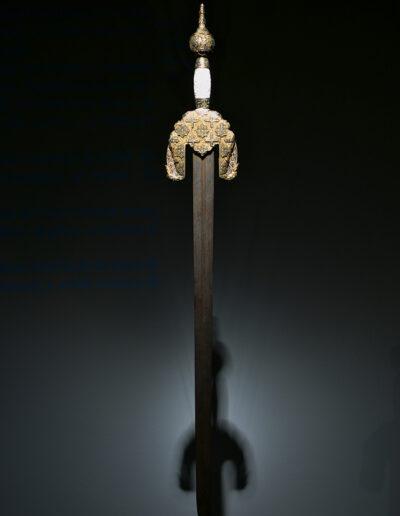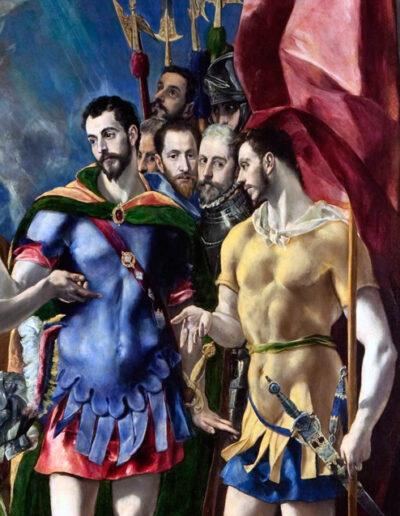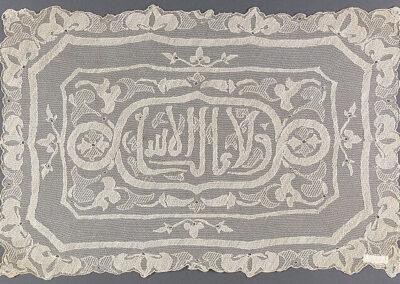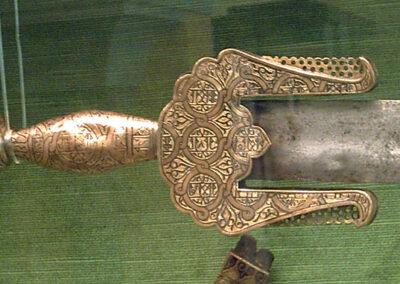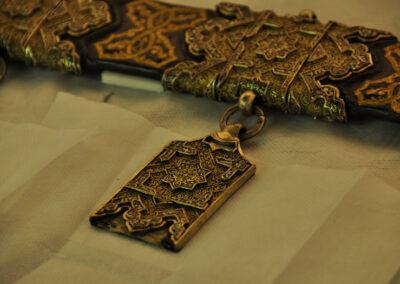
The citadel of the Alhambra and the inseparable orchard named the Generalife (the Nasrid kings’ summer residence) have been silent witnesses of the shift of civilizations, perennial watchmen over the city of Granada.
Centres of power of a kingdom of 28,000 square kilometres (Granada, Malaga and Almeria), these strategic enclaves were awarded by the Catholic Monarchs, after the conquest in 1492, to respective wardens or governors, whose military and judicial power made them a sort of viceroys of the new Christian power.
These noble dynasties were headed, on the one hand, by the marquis of Mondéjar, don Íñigo López de Mendoza, who ruled the Alhambra and, on the other hand, further on in time, the marquis of Campotéjar, in control of the Generalife’s territory.
These noble families in command of these properties during the centuries that followed the Muslim domination also received the “swords of King Boabdil”. It is about a dozen swords of the so-called “jineta” type, true jewels of the Hispanic Muslim art.
Those of Mondéjar and those of Campotéjar thus became kind of “marquise-kings” in both areas. Both the marquises of Mondéjar and Campotéjar belonged to lineages of very different origins. Their power, under the privileges recognised by Spanish kings over the course of centuries, was absolute (political, economic and judiciary) within the Alhambra and Generalife’s dominions. As a symbol of the power they held, every marquis who inherited such wonderful palaces received also one of the “Boabdil’s swords” true jewels made more for pomp than for combat.
The Mendozas, marquises of Mondéjar, governors of the Alhambra
The Mondéjar, descendants of the Mendoza line, were castellanos viejos (old Castilians, meaning they had no Jewish or Muslim blood) from Alava, the birthplace of Íñigo López de Mendoza, the first governor of the Alhambra. This lineage was in office at the Alhambra until the 18th century, when the Crown cancelled hereditary rights and asked the return of the possessions. This sword that symbolised the Granadan power of this family remained in the hands of one or another branch of the Mendozas until the1940’s, when it was finally donated to the San Telmo Museum near the beach of La Concha in San Sebastian. According to the museum’s historian, Arantxa Barandiarán, we know that this donation took place in 1941 by Blanca Porcel y Guirior, marquise of San Millán y de Villalegre and baroness of Sagarrén.
It remained hidden for several years until February 1982, when it was decided to build a showcase specially to be shown in the painting galleries of that museum in San Sebastian, where it is found today as the only piece of armoury shown in this museum.
The Mendoza lineage has owned for centuries one the two swords called “of Boabdil”. The piece is truly beautiful. It is about 37 inches long and it is made of silver, adorned with enamels, ivory and silver. It features two heads that descend to cover the beginning of the edges of the hilt, adorned with arabesques made of enamel and filigree. The pommel displays the Nasrid coat of arms, making it the only one among all the jinetas attributed to Boabdil that features this emblem. It was restored in the of the Army Museum in Madrid in 1977 and exhibited in the Palace of the Infantado in Guadalajara (Spain) and in the exhibition commemorating the IV Centenary of the publication of Don Quixote.
According to the Arabist don Basilio Pavón Maldonado, it is a Granadan work dating from the 15th century. As a curious fact, let us mention that among the preserved rapiers produced in Granada at that time, this one bears the closest resemblance to the one painted by El Greco in his work The Martyrdom of Saint Maurice that is housed in El Escorial.
The Granada Venegas, marquises of Campotéjar, governors of the Generalife
While the Mendozas, marquises of Mondéjar, governed the Alhambra, the other Granadan palace, the Generalife, had their wardens with a very different origin: the Granada Venegas, a family that hind behind its surname “Granada” their condition of Muslim converts. They were not, however, just more converted Moorish like others: the family “Granada” was of royal blood, as they were direct descendants from King Yusuf IV. From this king departs a Nasrid branch, the al-Nayar, which disputed the throne to the ‘official’ branch of the al-Ahmar.
The al-Nayar were known as the Infants of Almeria. One of its members, Sidi Hiayya al-Nayar, converted to the faith of Christ when he understood the inevitable Christian victory (he was baptised once the city of Baza surrendered), and his godparents were the Catholic Monarchs themselves. When he received baptism, he adopted the name of Pedro of Granada. His descendants, who were to be known as the Granada-Venegas, would join nobility after having received the title of Marquises of Campotéjar, and were appointed governors of the Generalife, which remained private property until the 20th century. The Casa de los Tiros, a Granadan noble mansion, was other of the holdings that this family of Nasrid ancestors had in Granada.
One of the swords we are talking about, the so-called “Boabdil’s swords” remained in the hands of this family’s descendants of the kings of Granada. This jineta sword, of a beautiful and rich workmanship, has been recently found in the palace of an Italian branch that the Granada-Venegas family has in Genoa. It is not on display to the public though. Not only that: the palace is private, and access is not permitted.
The family always kept in their coats of arms the motto: wa-la galiba illa Allah (‘Only God is Victorious’), the same one that appears on the walls of the Alhambra. The so-called ‘Boabdil sword’ (actually that of Yusuf IV, as we have already mentioned), the one that the Catholic Monarchs gave to the governor of the Generalife. It passed from hand to hand from century to century, from every member of the XVII marquises of Campotéjar −all of them descendants of Yusuf IV, from the al-Nayares, the Granada- Venegas− from the year 1643 until 1921. This beautiful sword presided over the noble hall of the Casa de los Tiros, but since 1921 nobody knew its whereabouts.
This sword, the symbol of the power of the marquis of Campotéjar (last descendant, as we can see, of the Nasrid royal family in Spanish soil), greatly interested scholars such as Miguel Castillo Higueras. In the eighties of the last century, he delved into its whereabouts, and he even appraised the possibility that it might be in Rome, donated by any of the marquises of Campotéjar to the Holy See. But it was not there. However, one who had seen the rich sword exhibited in a niche in that Genoese palace is the historian Adela Fábregas, who could admire its beauty in the halls of the palace of Durazzo-Pallavicini while she was undertaking research in Genoa.
Boabdil’s swords is located, although nobody could check it or contemplate its beauty. In Granada, almost nothing remains of any link between the Generalife and its Genoese owners. Even today, despite the changes that have taken place in the Generalife palace, we can see above the lintel of the Lions Gate the coat of arms of the Granada-Venegas family (five pomegranates) crossed with the Durazzo-Pallavicini’s arms. The wife of the 17th and last Italian Marquis of Campotéjar, the marquise Matilde Giustiniani, coordinated the clearance of the Granadan palace Casa de los Tiros, the Granada-Venegas stately home for centuries. Among the belongings that were transported to Genoa was Yusuf IV’s sword, which was kept in a wooden box in the Casa de los Tiros.
The magnificent swords named jinetas or ginetas −also known in the 16th and 17th centuries as Moorish swords, which were used in the cavalry practices, so characteristic of those times− are the most direct, clear and rich inheritance of the Hispano-Arabic panoply. We can find its name’s origin, according to the Chronicle of Alphonso X, in the Berber tribe of the Marinids, also known as Zenatas, who entered the Iberian Peninsula in the 13th century to support Muhammad I of Granada in battle against Christian armies.
They brought along a new method of cavalry combat, ‘a la jineta’ whose main features were the short stirrups, light weapons and rapid movements. Apart from that, they brought this type of lighter and shorter weapon, with the same width as the Christian sword of the time. The quillons of the cross guard are bent towards the blade in parallel to the edge of it, and they used to bear animal forms. The hilt is narrow and the pommel spherical, sometimes flattened.
The entire grip and the fourreau, in the cases when they are preserved, were profusely decorated. Due to the beauty of its ornamentation and the rarity of its number (around a dozen) they are valued and admired both by outside the fields of art and history, as well as of ancient weaponry.
Some of them are not in in Spain. The three museums in Spain where we can find them are the Army Museum (with two copies and the National Archaeological Museum in Madrid, and the San Telmo Museum in San Sebastián. The Museum of Kassel (Germany), the Metropolitan Museum of New York and the National Library of Paris also host jinetas copies.
César de Requesens Moll
Journalist and writer.

. Embroidered tablecloth with the Nasrid motto ‘Only God is Victorious’ (wa-la galiba illa Allah).
©Metropolitan Museum of Nueva York
The most famous jineta sword
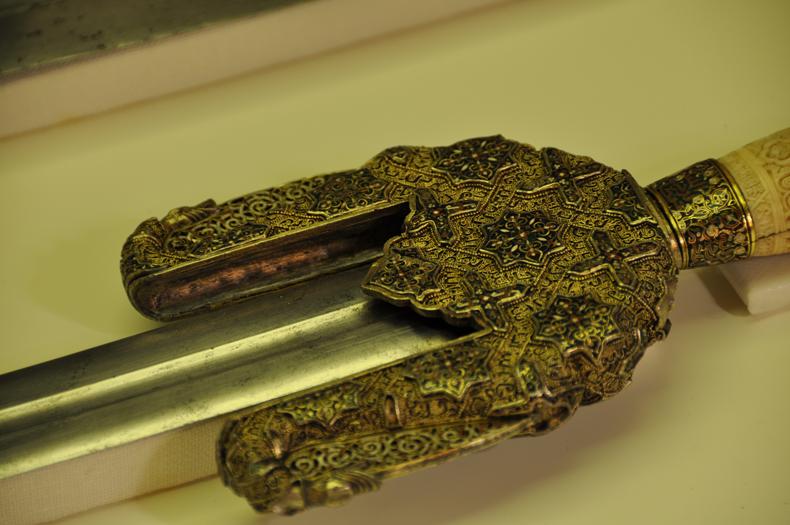
Of all the swords attributed to the last Nasrid monarch, Boabdil El Chico, we can find one, with a gilded hilt, in the Army Museum of Madrid. This sword is exhibited together with the royal rapier that belonged to the Granadan King and the marlota (a type of robe) in red velvet with gold ornaments, a pair of slippers carefully executed and the Alhamar dynasty King Muhammad V’s leggings.
In 1483, as the Battle of Lucena was taking place, the sword, together with the rest of the artifacts belonging to Boabdil’s personal dowry, were taken away by Diego Fernández de Córdoba, whose heirs kept it in their possession until they donated it in 1904 to the Army Museum of Madrid.

Boabdil’s robe kept in the del Museo del Ejército Army Museum (Madrid), which was shown at the exhibit Art and Cultures of al-Andalus The power of the Alhambra, celebrated during 2013. This great exhibition was co-organized by El legado andalusí Andalusian Public Foundation in collaboration with the Council of the Alhambra and Generalife, and other institutions, entities and experts on the history of the universal monument.


